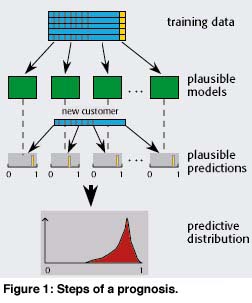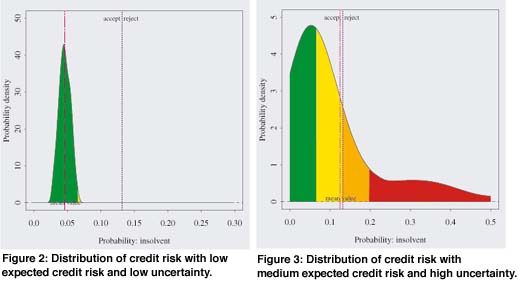ShowRisk - Prediction of Credit Risk
by Gerhard Paaß
The growing number of insolvencies as well as the intensified
international competition calls for reliable procedures to evaluate
the credit risk (risk of insolvency) of bank loans. GMD has developed
a methodology that improves the current approaches in a decisive
aspect: the explicit characterization of the predictive uncertainty
for each new case. The resulting procedure does not only derive
a single number as result, but also describes the uncertainty
of this number.
Credit Scoring procedures use a representative sample to estimate
the credit risk, the probability that a borrower will not repay
the credit. If all borrowers had the same features, the credit
risk may be estimated. Therefore the uncertainty of the estimate
is reduced if the number of sample elements grows. In the general
case complex models (eg neural networks or classification trees)
are required to capture the relation between the features of the
borrowers and the credit risk. Most current procedures are not
capable to estimate the uncertainty of the predicted credit risk.
Prediction with Plausible Models
We employ the Bayesian theory to generate a representative selection
of models describing the uncertainty. For each model a prediction
is performed which yields a distribution of plausible predictions.
As each model represents another possible relation between inputs
and outputs, all these possibilities are taken into account in
the joint prediction.

A theoretical derivation shows that the average of these plausible
predictions in general has a lower error than single ‘optimal’
predictions. This was confirmed by an empirical investigation:
For a real data base of several thousand enterprises with more
than 70 balance sheet variables, the GMD procedure only rejected
35.5% of the ‘good’ loans, whereas other methods (neural networks,
fuzzy pattern classification, etc.) rejected at least 40%.
Expected Profit as Criterion
The criterion for accepting a credit is a loss function specifying
the gain or loss in case of solvency/insolvency. Using the predicted
credit risk we may estimate the average or expected profit. According
to statistical decision theory a credit application should be
accepted if this expected profit is positive. Depending on the
credit conditions (interest rate, securities) this defines a decision
threshold for the expected profit.

In figures 2 and 3 the decision threshold for a credit condition
is depicted: If the predicted average credit risk is above the
threshold, a loss is to be expected on average and the loan application
should be rejected. Figure 2 shows a predictive distribution where
the expected credit risk is low. The uncertainty about the credit
risk is low, too, and the loan application could be accepted without
further investigations. The expected credit risk of the predictive
distribution in figure 3 is close to the decision threshold.
The actual credit risk could be located in the favourable region
the intermediate range or in the adverse region. The information
in the training data are not sufficient to assign the credit risk
to one of the regions. Obviously the data base contains too few
similar cases for this prediction resulting in an uncertain prediction.
Therefore in this case there is a large chance that additional
information, especially a closer audit of the customer, yields
a favorable credit risk.
Application
Under a contract the credit scoring procedure was adapted to the
data of the German banking group Deutscher Sparkassen und Giroverband
and is currently in a test phase. For each new application it
is possible to modify the credit conditions (interest rate, securities)
to find the conditions, where the credit on the average will yield
a profit. For a prediction the computing times are about a second.
Currently an explanation module is developed which will explain
the customer and the bank officer in terms of plausible rules
and concepts, why the procedure generated a specific prediction.
Please contact:
Gerhard Paaß - GMD
Tel: +49 2241 14 2698
E-mail: paass@gmd.de
